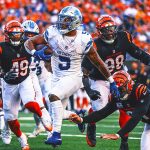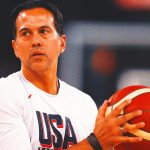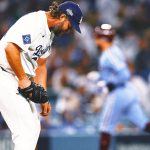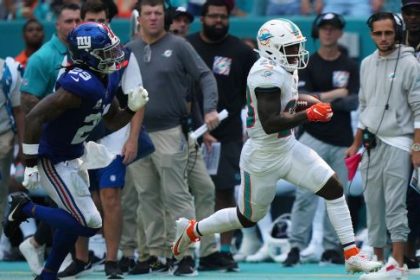Adrián Beltré coasted to Cooperstown on Tuesday in his first year on the Baseball Hall of Fame ballot. His tremendous production over 21 seasons made him one of the game’s all-time great third basemen. His antics on the field made him one of the most enjoyable to watch.
Beltré received 95.1% of the vote — far more than the required 75% for election — a reflection of his talent and longevity as well as the joy and vivaciousness with which he played and persevered throughout a circuitous major-league journey. He checked all the boxes required for induction, though he did so in a manner unlike anyone else.
The one-time prodigy who was signed (illegally) at 15 years old authored his best work 15 years later. Beltré is the only player in MLB history with at least 3,000 hits and 450 homers while playing at least half of his games at third base. The fact that more than half of his 3,166 hits — and all four of his All-Star appearances — occurred in his 30s made it all the more remarkable, particularly considering his extensive list of injuries and ailments he battled throughout his career, from a ruptured and infected appendix at 21 to thumb, calf and hamstring issues in his late 30s.
Beltré’s career spanned three decades, beginning as a preternatural 19-year-old in Los Angeles in 1998 when Tommy Lasorda fast-tracked him to the majors and ending as a 39-year-old superstar in Texas in 2018. He finished his career with the 18th-most hits and 15th-most games played in baseball history. By Baseball-Reference’s version of wins above replacement, he grades out as the third most valuable third baseman ever, behind Mike Schmidt and Eddie Mathews and ahead of Hall of Famers Wade Boggs, George Brett, Chipper Jones, Ran Santo, Brooks Robinson, Paul Molitor and the recently-elected Scott Rolen. By JAWS, which averages a player’s career WAR with that of his seven best seasons, he ranks fourth.
ADVERTISEMENT
He was a five-time Gold Glove winner who offered a complete arsenal, ranking in the top seven at his position all time in both offensive and defensive WAR.
But beyond his skill set, he also provided a daily reminder of why baseball fans fell in love with a kids’ game in the first place. Shawn Green once described him to the LA Times as “the perfect teammate.” Dodgers manager Dave Roberts shared a similar sentiment.
“He’s on my Mt. Rushmore of teammates,” Roberts, who played with Beltré for three years from 2002 to 2004 in Los Angeles, told FOX Sports. “The ability for him to compartmentalize, whether it be joking with a catcher in between at-bats, or a pitcher in between at-bats, or a baserunner at third base, and then he’s got to make a great barehanded play the next pitched ball, he just has that innate ability to be able to compartmentalize but continue to remain focused. That is just so difficult, and he mastered it.”
The longer Beltré played, the more comfortable he became with his place as a big leaguer — and the more fun he seemed to have. He would homer off one knee, including on his first career World Series home run. He would amusingly banter with Félix Hernández in Seattle and Elvis Andrus in Texas, providing daily entertainment.
When he was admonished for not standing on the on-deck circle in an 18-6 game, he instead brought the circle to him (and was subsequently ejected by former umpire and fun police chairman Gerry Davis). He was once pinch-run for and good-naturedly refused to leave. Another time, he grabbed a broom and pretended to prepare for battle to avoid a postgame Gatorade shower.
His playfulness went from the batter’s box, where he would dance on pitches that ran too far inside, to the basepaths, where he once fully turned around between second and third base to joke with Andrelton Simmons, to defense. He would initiate staredowns with opposing baserunners when they were stuck in a pickle. He once lightheartedly tried to push José Altuve off the bag at third. Another time, he flipped a foul ball down the third-base line over to Astros third-base coach Gary Pettis. When it bounced off Pettis’ chest with no reaction, Beltré did it again. His histrionics reached new heights alongside Andrus, who would do all he could to get a rise out of his veteran teammate.
Dating back to his time as teammates with Hernández, it became well-known that Beltré hated his head being touched. So, naturally, Andrus did it every chance he got. That once resulted in Beltré taking off his glove and throwing it at his teammate during a mound visit as Andrus scampered away. All of it seemed additive to team chemistry for a Rangers team seeking its first World Series title — and masked the numerous aches and pains that Beltré battled through much of his career. He never let his injuries damper his spirit.
“I think with Adrián, like I think with all Hall of Famers, they’re just cut from a different cloth,” Roberts said. “You can look at skill sets from all these different guys and they’re all talented, but I think the common thread is they have a mindset of determination, of will, that people just can’t parallel or match.”
None of Beltré’s physical setbacks were as scary as the life-threatening issue he faced before the 2001 season, when he needed an emergency appendectomy in his native Dominican Republic. Complications ensued. He spent weeks in the hospital, could not eat solid food for months and lost more than 30 pounds. That spring, he needed to be nourished through an IV port in his arm and wear a colostomy bag. He still tried to play with that bag tucked into his uniform and only missed a month of the season.
The next three years did not go the way the one-time wunderkind might have envisioned. His teammates could see the five-tool potential and his expertise at the hot corner, but offensive inconsistencies marred his play. He was impatient at the plate and posted below league-average numbers. Then came 2004, when bone spurs in his ankle threatened to derail a contract year in Los Angeles.
Instead, they might have helped ignite one of the greatest single seasons in Los Angeles history. Beltré was determined not to miss time. He pushed surgery off to the offseason. Every swing and miss caused severe pain, so he altered his free-swinging approach. He became more selective.
“I think [the injury] was the impetus to his great season, in the sense that it forced him to stay back on the baseball,” Roberts said. “I played with him in 2002 and ‘03, and early on, I think he was getting out front a lot. But once he had that injury to his left foot or ankle, it forced him to stay behind the baseball. Then he was using the big part of the field and slugging and putting together an MVP-type season.”
Beltré echoed that sentiment Tuesday in a conference call following his election.
“It’s no doubt I had to be more in control of my swing and understand I needed to be more focused on the pitch I want to hit, because if I didn’t make contact it was really painful,” he said.
Beltré finished the year with 200 hits, 121 RBIs and a major league-leading 48 homers while continuing to exhibit elite defense, which more modern metrics would reinforce. In 2004, only Rolen graded out higher in defensive runs saved — a stat that Beltré leads among all third basemen since it began being tracked in 2003.
“To this day,” Roberts said, “I don’t recall anyone being any better at the barehanded play.”
Beltré finished second in MVP voting to Barry Bonds in 2004 and parlayed the breakout into a five-year, $64 million deal in Seattle, where the weight of the contract, a difficult environment for right-handed hitters and a litany of injuries all played a factor in his modest production. In Boston, a one-year prove-it deal revived his career.
Playing in much friendlier hitting confines, Beltré was an All-Star for the first time while leading the majors with 49 doubles and orchestrating his best season since his last in L.A. At 30 years old, it stood to reason that might be his peak. Even the Rangers, who gave him a six-year, $96 million deal, couldn’t have known the ascension that would continue in Arlington.
Their decision could have backfired. To that point, Beltré was the virtuoso who had never fully materialized. Plus, he was displacing a franchise favorite in Michael Young, who had just logged 155 starts at third base in a 2010 season in which the Rangers had reached the World Series for the first time in their franchise’s history.
In Texas, Beltré rewrote his narrative. After his 2004 breakout, Beltré’s next seven best seasons all took place after turning 30. Six of them occurred in Texas, where he recorded his 3,000th hit, becoming the first Dominican-born player to accomplish the feat. (By WAR, just 15 other players were better in their 30s; he’s the only player on that list to have played into the 2000s.
He also endeared himself to his new fan base quickly.
Both Beltré and Young, as a third baseman and designated hitter, respectively, were All-Stars in their first season together. Beltré went on to post an .844 OPS that postseason, launching three homers in Game 4 of the 2011 American League Championship Series against the Rays and homering in Games 5 and 6 of the World Series in a gut-wrenching seven-game defeat to the Cardinals. He became a fixture at the hot corner in Texas, applauded for his ability to play through pain, including a torn ligament in his thumb throughout the second half of 2015. That year, the Rangers had a one-game lead on the Astros in the AL West entering the final day of that season, when Beltré’s home run helped cement the division. By then, he had also cemented himself as an all-time Rangers great. A player capable of greatness but prone to volatility had finally found consistency.
Beltré noted Tuesday that when he looks back at his career, he’s most proud of his ability to stay on the field. Despite his lengthy injury history, he played more than 140 games 14 times. And he performed.
From 2010 to 14, he hit at least 30% better than league average every season and made the All-Star team four times. He finished his eight-year Rangers tenure with a 128 OPS+ — 20 points better than his seven years in Los Angeles and 27 points better than his five years in Seattle. His late-career production lifted him into surefire Hall of Fame territory. His enjoyment made him must-see TV.
“He made the game fun but knew when to get serious,” Roberts said. “I was a better player and manager because I got to be teammates with Adrián Beltré.”
Rowan Kavner covers the Dodgers and MLB as a whole for FOX Sports. He previously was the Dodgers’ editor of digital and print publications. Follow him on Twitter at @RowanKavner.
recommended

Get more from Major League Baseball Follow your favorites to get information about games, news and more









